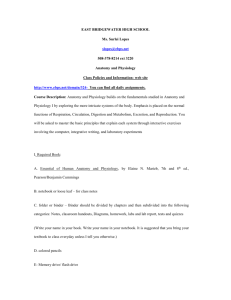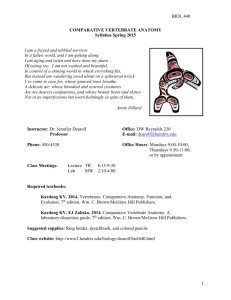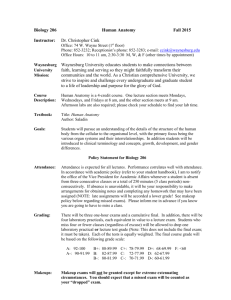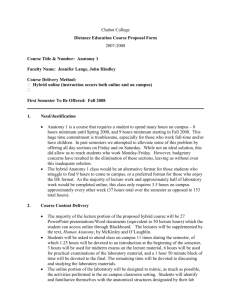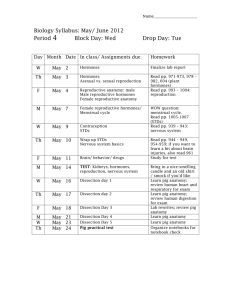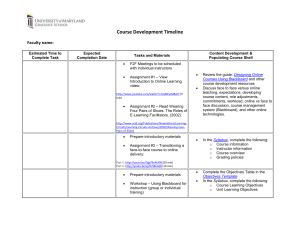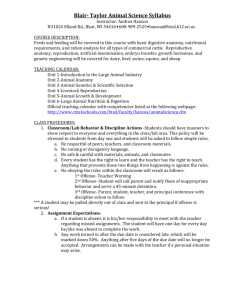MIRACOSTA COLLEGE
advertisement
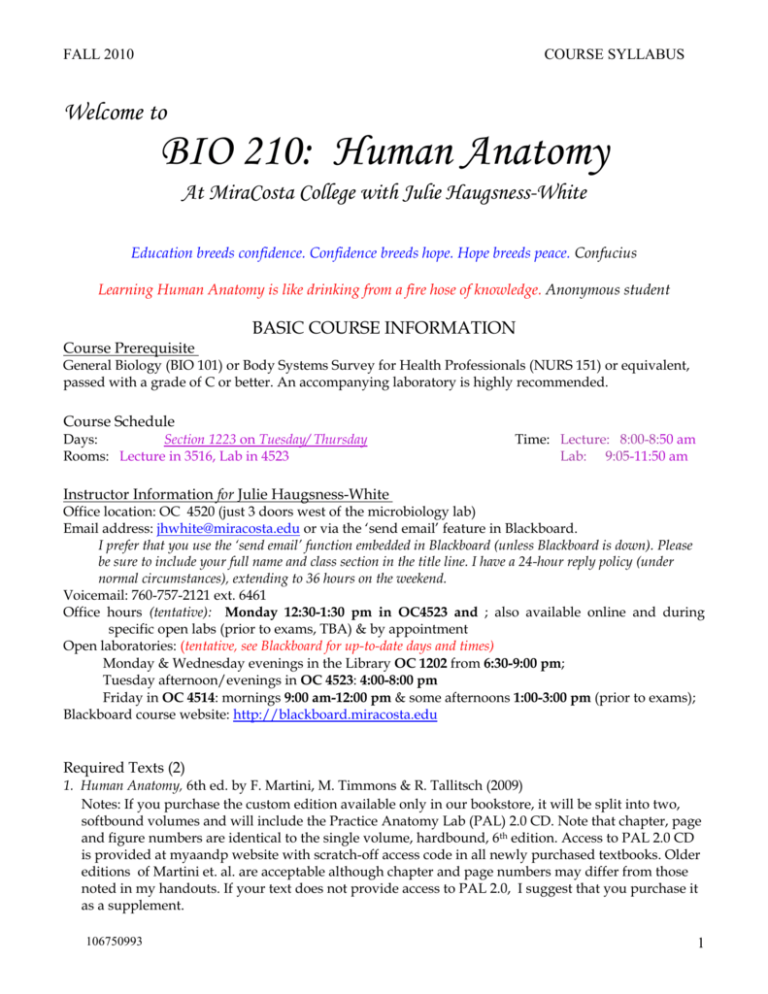
FALL 2010 COURSE SYLLABUS Welcome to BIO 210: Human Anatomy At MiraCosta College with Julie Haugsness-White Education breeds confidence. Confidence breeds hope. Hope breeds peace. Confucius Learning Human Anatomy is like drinking from a fire hose of knowledge. Anonymous student BASIC COURSE INFORMATION Course Prerequisite General Biology (BIO 101) or Body Systems Survey for Health Professionals (NURS 151) or equivalent, passed with a grade of C or better. An accompanying laboratory is highly recommended. Course Schedule Days: Section 1223 on Tuesday/ Thursday Rooms: Lecture in 3516, Lab in 4523 Time: Lecture: 8:00-8:50 am Lab: 9:05-11:50 am Instructor Information for Julie Haugsness-White Office location: OC 4520 (just 3 doors west of the microbiology lab) Email address: jhwhite@miracosta.edu or via the ‘send email’ feature in Blackboard. I prefer that you use the ‘send email’ function embedded in Blackboard (unless Blackboard is down). Please be sure to include your full name and class section in the title line. I have a 24-hour reply policy (under normal circumstances), extending to 36 hours on the weekend. Voicemail: 760-757-2121 ext. 6461 Office hours (tentative): Monday 12:30-1:30 pm in OC4523 and ; also available online and during specific open labs (prior to exams, TBA) & by appointment Open laboratories: (tentative, see Blackboard for up-to-date days and times) Monday & Wednesday evenings in the Library OC 1202 from 6:30-9:00 pm; Tuesday afternoon/evenings in OC 4523: 4:00-8:00 pm Friday in OC 4514: mornings 9:00 am-12:00 pm & some afternoons 1:00-3:00 pm (prior to exams); Blackboard course website: http://blackboard.miracosta.edu Required Texts (2) 1. Human Anatomy, 6th ed. by F. Martini, M. Timmons & R. Tallitsch (2009) Notes: If you purchase the custom edition available only in our bookstore, it will be split into two, softbound volumes and will include the Practice Anatomy Lab (PAL) 2.0 CD. Note that chapter, page and figure numbers are identical to the single volume, hardbound, 6th edition. Access to PAL 2.0 CD is provided at myaandp website with scratch-off access code in all newly purchased textbooks. Older editions of Martini et. al. are acceptable although chapter and page numbers may differ from those noted in my handouts. If your text does not provide access to PAL 2.0, I suggest that you purchase it as a supplement. 106750993 1 FALL 2010 COURSE SYLLABUS 2. A Photographic Atlas for the Anatomy & Physiology Lab, 6th ed. by Van de Graff (2007), Morton Important note: As an alternative to Van de Graff, you may purchase the two asterisked* references, listed under ‘Optional References’ below. Together these offer a more comprehensive laboratory text. Suggested Supplements 1. Dictionary of Word Roots and Combining Forms, by D.J. Borror (1988), Mayfield Pub. Co. Most students find this invaluable for learning the ‘language’ of anatomy. I recommend it to all. 2. Practice Anatomy Lab 2.0 (otherwise known as the “PAL CD”), Pearson Pub. If you purchased a new textbook in our campus bookstore you will already have access to it. If not, purchase it to use as a valuable study tool for all aspects of our laboratory course. Optional References (I suggest you wait to purchase optional materials until we discuss them in class.) 1. *LeBoffe, M.J. (2003), Photographic Atlas of Histology, 1st ed., Morton Pub.* 2. *Sebastiani, P.B. (2005), Mammalian Anatomy: The Cat, 2nd ed., Morton Pub.* 3. Krieger, Paul A., 2005, A Visual Analogy Guide to Human Anatomy, Morton Pub. This is an excellent resource for students who have trouble memorizing scientific details. 4. Bowden,B.S. & J.Bowden, 2005, An Illustrated Atlas of the Skeletal Muscles, 2nd ed., Morton Pub. This is a great resource for students headed into physical/occupational/massage therapy, kinesiology, athletic training or chiropractic medicine. COURSE CONTENT & LEARNING OUTCOMES Course Description According to the MiraCosta course catalog, you will be exposed to the fundamental gross and microscopic anatomy of the human body following a systemic approach. Some of the topics to be covered include the following body systems: integumentary, skeletal, muscular, nervous, digestive, respiratory, cardiovascular, lymphatic, urinary, reproductive and endocrine. You will also study histology, joints and special senses. In the laboratory you will participate in dissection of a mammal (cat or rabbit), sheep heart, sheep brain, cow eye and you will study previously dissected cadavers (both male and female). 4 units credit Biological Sciences Department Mission Students in the life sciences will become scientific thinkers who are curious and knowledgeable about biological systems and who rely on experimentation, logic, evidence, objective reasoning and healthy skepticism to explain natural phenomena. Course-level Student Learning Outcomes (SLOs) Our department predicts that 65% or more of the enrolled students will achieve the student learning outcomes for BIO 210 as stated below. Upon completing the course successful students: Can distinguish which tissue types are present in a given histological section (microscopic view) of an organ, and justify the organization of those tissues based upon their functional roles. Can demonstrate appropriate dissection techniques on preserved specimens, applying a systemic approach. Can evaluate how the differences among people (i.e. gender, age, health, heredity) affect the structure and function of the human body. 2 106750993 FALL 2010 COURSE SYLLABUS Note that the national Human Anatomy and Physiology Society (HAPS) has set forth a complete list of learning outcomes for college-level, combined Anatomy & Physiology classes. I can demonstrate this list to you by request, although it does not strictly apply to our course since students generally study human anatomy and human physiology in a two-semester sequence here at MiraCosta College. Course Objectives In order to achieve the outcomes listed above, students enrolled in this course will learn to: Identify major bone features, muscles, organs, nerves and vessels of the human body; describe their structure and basic function; and explain how they integrate with other body systems. Prepare a mammalian dissection plan following the systemic approach; and summarize dissection techniques. Display fundamental skills in microscope use; and interpret microscope slides of vertebrate tissue sections, relating tissue microstructure to organ macrostructure. Compare and contrast the structures of the mammalian body at the cellular, tissue, organ and system levels of organization. Analyze and solve problems in specific and limited clinical situations, especially as relates to the aging process. A ROAD MAP TO LEARNING Introduction Human anatomy is an information-dense discipline. It can be a challenge to read and understand the textbook without having your attention wander. I will be delivering course content to you in a variety of modalities, in the hopes that by seeing, hearing, writing, talking, and/or touching the anatomical content you will develop a deep understanding of human morphology alongside an abiding appreciation of its complexity. According to William Glasser, the author of choice theory: “We learn... 10% of what we read 20% of what we hear 30% of what we see 50% of what we both hear and see 70% of what is discussed 80% of what we experience personally 95% of what we teach to someone else” The Weekly Instructional Routine 1. 2. 3. Preview the weekly topic (as noted on the syllabus) by reading the textbook and attempting to complete the pertinent lecture and lab learning objectives. Attend lecture ‘religiously’ and either tape record the lecture, sit back and listen intently; or follow along in the textbook with a hi-liter while you listen to the lecture; or take comprehensive lecture notes. Your method of lecture interaction will depend upon your identified learning style(s). Come to lab prepared to engage in the scheduled &/or announced activity(s). Remember to download and print pertinent study guide/lab exercise documents and to bring to class your lab manual(s). If there is a dissection plan due, be sure to complete it prior to attending lab. 106750993 3 FALL 2010 COURSE SYLLABUS 4. Complete the assigned homework in a timely way. It is designed to facilitate your learning and/or to challenge your understanding. It is most effective and relevant when it is completed on time. 5. Make the wise choice to study anatomy regularly and frequently. Consider attending a weekly Learning Community &/or open lab, working with a tutor or forming your own study group that meets regularly. Do not wait for impending exams to learn the material, it will be too late. LABORATORY-SPECIFIC INFORMATION Recommended Lab Materials The biology department supplies essential dissection tools, plastic aprons, protective sleeves and eye goggles. You must supply your own protective gloves: nitrile gloves are my personal preference (allergen-free), latex are the most economical, and Playtex living gloves are reusable. The most important point is to buy gloves sized to fit your hands well. You will use them extensively in Units 2-4, so buy them in bulk. There is a designated cabinet in the laboratory for storing your personal items. Lab Procedures Food and drink are not allowed in the anatomy lab. Please finish them before entering the classroom or secure them in your backpack. Closed-toe shoes must be worn in the laboratory. Should you forget, you will be asked to wear our goofy yellow boots or our lovely bedroom slippers. You are welcome and encouraged to store a pair of shoes in the lab. It is your responsibility to clean up after each lab session. This means returning all equipment and supplies in good condition to their storage places, putting all tissue waste into the proper receptacle (as per classroom instructions), properly stowing preserved specimens & wiping down all work surfaces with a disinfectant cleaner. Please read carefully and follow all protocols described in the Anatomy Laboratory Etiquette doc. STUDENT EXPECTATIONS & RESPONSIBILITIES You have both rights & responsibilities as a student at MiraCosta College. Please refer to the 2010-11 MCC College Catalog, pages 276-286 to read more about your student responsibilities. You can expect me to protect your student rights & to enforce academic integrity at all times in my classroom. Be advised that academic dishonesty includes but is not limited to cheating on a quiz or exam (e.g. use of unapproved resources, copying or supplying answers, employing a test taker), plagiarizing a writing assignment (e.g. copying another’s work without citation), and unauthorized removal of equipment or supplies (e.g. microscopes, microscope slides, bones, cadaver parts, models, references) from a classroom, office, or the library/information hub. Consequences for all parties involved in an academic dishonesty incident may include any or all of the following actions: a.) a verbal warning, b.) a score of 0 on that quiz/exam/assignment (that can not be made up with another chance or equivalent assignment), c.) an academic dishonesty incident report, with or without a recommendation for dismissal from the course, filed with the Vice President of Student Services, Dick Robertson. Let’s work together to build a classroom-learning environment that meets everyone’s needs and is based upon 4 106750993 FALL 2010 COURSE SYLLABUS mutual trust. We will develop a set of classroom policies through a discussion thread on Blackboard. 106750993 5 FALL 2010 COURSE SYLLABUS Attendance and Withdrawal Policy You are expected to attend all class meetings (both lecture and laboratory), and to stay for the entire scheduled class-time. If you should miss class, it is your responsibility to acquire any and all material(s) from a classmate, including announcements of schedule changes. If you miss a scheduled lab, it is your responsibility to meet the covered lab objectives independently using open lab resources, your group mates &/or campus tutors. If you miss 4 classes you may be dropped from the course (prior to Nov. 18th) Missed quizzes/in-class assessments cannot be made up at a later date. Please communicate with me during extended absences. I encourage you to consult with me frequently about your progress. If you decide to withdraw from this course, it will be your responsibility to initiate the drop by completing the required forms and meeting the school deadlines. Important Dates: Sept. 4: Sept. 6: Oct. 23: Nov. 12: Nov. 18: Nov. 25-28 Last day to drop classes with no grade placed on your permanent record. Holiday (Labor Day), no Monday classes Encuentros Education & Career Exploration Conference, Oceanside Campus, 9 am-2 pm Holiday (Veteran’s Day), no Friday Open Lab Last day to drop classes and receive a W on your permanent record. Holiday (Thanksgiving), no Thursday classes, no Friday Open Lab, all campus facilities closed for the weekend. ASSESSMENT & GRADING POLICY Overview of Assessments Your performance in this class will be evaluated by a combination of homework assignments, scheduled quizzes, lab demonstrations, 4 lecture exams and 4 laboratory practica (or the equivalent thereof). I reserve the right to divide any major lecture exam or lab practicum (valued at 100 points each) into smaller assessments for logistical or pedagogical reasons (I’ve already done this for the unit 4 exams). Homework assignments (45 points total) Homework will be assigned online at our Blackboard course website for each of the 4 units of study and will be valued at 15 pts. per unit. Homework for each unit will have clearly stated due dates, that should be duly noted on your planning calendar, given that late work will not earn credit. The lowest of the 4 homework scores will be dropped. Students who are able to earn an ‘A’ on the first major lecture exam and laboratory practicum (scheduled in week 5) may elect a ‘no-homework’ option for the course. Dissection Plans (30 points total) You will be required to collaboratively write three dissection plans this semester. The first one will be assigned in unit two (see course schedule for exact due date.) You will be planning the dissection of an assigned region of cat musculature for your second dissection lab. Another plan will be written for the sheep heart dissection, in order to direct your dissection of the 4 cardiac valves. The third dissection plan will be assigned in unit four. You will be asked to prepare to dissect & display a focused group of structures (TBA) located in a ventral body cavity (e.g. blood vessels &/or organs.) You will be given additional instructions prior to each assigned dissection plan. Your first dissection will be guided by an instructor-written dissection plan. Additional instructions and examples are forthcoming. 6 106750993 FALL 2010 COURSE SYLLABUS Laboratory demonstrations (50 points total) 1. Each student will be asked once, to orally demonstrate a group of testable structures to the class, in preparation for the practical exams. You may elect to demonstrate any of the following resources: histology/microscopic anatomy, bones, models, sheep/cow organs, or organ systems on either the cat or a cadaver; although your demonstration must be pre-approved by the instructor. You will present a minimum of 15 features in front of the instructor and a minimum of 3 other students. You may use your study guide as a casual reference during the demonstration but must know the material being presented. To earn the full 25 points credit you will present with accuracy and confidence. You may attempt this activity twice; I will record the highest score attained. Approximately ¼ of the class will demonstrate in each unit of study. 2. Each dissection group will present a labeled cat or sheep organ dissection to the rest of the class, to be used as a study specimen prior to practical exams for units 2-4. Approximately 25 structures must be presented & accurately labeled to earn the full 25 points credit. Group members who are absent or do not participate will earn 0 points. They may have a second chance at a later date. It is your responsibility to participate in a group demonstration prior to the final practical exam. 3. Alternate group assignment: You may collaborate with two fellow anatomy students on the planning and implementation of an instructional activity involving some aspect of human anatomy. Your activity will be presented to the participants of the 7th Annual ENCUENTROS Education and Career Exploration Conference on Oct. 23rd. You will need to commit to: attend the fair; participate in delivering your activity for a minimum of 3 hours; help out with either setup or cleanup. Besides earning course credit in lieu of a dissection group demonstration (#2 above), you will earn service-learning credit for your resume and the pride that comes from community service. Note: Instead of earning group presentation points you may elect to earn 10 points extra credit. Lecture exams & quizzes (450 points total) Written exams will evaluate your understanding of the material covered in both lecture and lab. They will contain a combination of multiple choice, matching and short answer/essay questions. Exam questions will focus on the lecture and laboratory learning objectives for each unit of study, and will test your ability to think critically, to integrate concepts, and to apply them in novel scenarios. You will need to purchase 4 Scantron answer sheets for exams. The four major lecture exams are valued at 100 points each; in addition there will be two lecture quizzes valued at 25 points each. See course schedule for exact dates and put these onto your personal planning calendar now. Laboratory practica & quizzes (450 points total) Lab practica are hands-on exams that will evaluate your ability to identify specific anatomical structures; no list of names will be provided to jog your memory. The practical exams will assess your knowledge of: human bones/skeletons; cadavers/prosections; dissected cats, cow & sheep organs; anatomical models, and microscope slides of cells, tissues & organs. Note that you will be graded on spelling, since correct spelling (and pronunciation) of anatomical terms is critical for effective communication in all professional settings. You will have 4 practical exams, valued at 100 points each, as indicated on the course schedule. Prior to the first practical exam I will set up a practice test to familiarize you with the format. Lab groups will be earning demonstration points for presenting labeled specimens for study prior to each of the 3 remaining lab practica; these will effectively serve as practice tests for units 2-4. 106750993 7 FALL 2010 8 106750993 COURSE SYLLABUS FALL 2010 COURSE SYLLABUS You will also have 2 laboratory quizzes as indicated on the course schedule. Each quiz will be valued at 25 points. The first lab quiz will assess your ability to identify connective tissue histology; and to accurately identify and name human bones. The second lab quiz will assess your knowledge of sheep brain anatomy from designated websites; and of the microscopic anatomy of the spinal cord, a myelinated nerve, the eye (including retina) & the cochlea (inner ear). Policy for missed exams A single missed lecture exam may be made up only if I have received prior notice in writing of an excusable absence; or if I receive an emergency phone call (for unforeseeable and justifiable reasons) within 24 hours of the scheduled exam. If I do not hear from you within 24 hours of a scheduled exam you will not be allowed a makeup exam and will earn a score of zero points for that exam. If you are excused from taking a lecture exam at the normally scheduled time, you must be prepared to take it on the first day that you return to class. All makeup exams may consist entirely of essay questions. Additional missed lecture exams (e.g. more than one) cannot be made up and will be scored @ zero points each. Due to the nature of lab exams, a missed lab practicum or lab quiz cannot be made up. You must therefore attend class on the scheduled day of a lab practical or lab quiz OR earn a score of 0 points for it. Grading Policy Your final course grade will be based on the total number of points that you accumulate in both lecture and lab throughout the entire semester. Please note that if your total points end up near a grade boundary, you will be assigned the grade that you earned, not the grade that you got ‘really close to’. Your grade is not negotiable. Assessment Opportunities Point Totals 4 Lecture Exams (100 pts. each) 400 pts. 2 Lecture Quizzes 50 pts. 4 Lab Practica (100 pts. each) 400 pts. 2 Lab Quizzes (25 pts. each) 50 pts. 3 Units of Homework Assignments (15 pts.) 3 Group Dissection Plans (10 pts.) 45 pts. 30 pts. 2 Laboratory Demonstrations (25 pts. each) 50 pts. Total Points Possible Grade Tracking 1025 pts. MY GOAL IS _____________ First, set a realistic goal for the grade you want to achieve this semester. Go ahead and write it down. Next, follow your progress on Blackboard by clicking on the “My Grades” button (if available); alternatively, follow your progress manually on the grade tracking form on the last page of the syllabus. Enter your grade for each completed assessment, then add it to the previous row's cumulative points in order to determine your current total point total for the course. Your current course grade can be determined by dividing your cumulative point total by the total points possible to date, and multiplying by 100. Finally, use the grade rubric below to determine your current letter grade in the course. By 106750993 9 FALL 2010 COURSE SYLLABUS tracking your progress throughout the semester, you can continue to adjust your study habits &/or your expectations in order to achieve your goal this semester in anatomy. Grade Rubric: Letter grades will be assigned on a straight percentage basis as follows: A = 90% - 100% B = 78% - 89.9% C = 65% - 77.9% D = 55% - 64.9% F = 0% - 54.9% Other Grading Options The pass/no pass grading option is available by petition before Sept. 24th. A grade of C or better = Pass. Please note that the incomplete grade is available by petition for “unforeseeable, emergency & justifiable reasons” only and generally you must have already completed 75% of the course. Extra Credit Opportunities Limited extra credit points can be earned for instructor-approved, enrichment activities only. Participation in the ENCUENTROS conference will present one such opportunity. Other service learning opportunities, science seminars and allied health club activities will be available for extra credit. Watch for pertinent details to be announced in class and posted on Blackboard. A maximum of 10 extra credit points will be allowed for the entire semester. A cutoff date of Nov. 29th to submit extra credit work will be strictly enforced. VALUABLE STUDENT RESOURCES Open Laboratories Limited open laboratory opportunities may be available to review lab materials outside of class-time alongside students from other sections of anatomy. Having access to our department resources is a privilege that can be withdrawn. Please follow the protocol established for open labs; it is your responsibility to abide by this protocol or open lab may be canceled. Note that cadaver viewing and continuing cat dissection will only be allowed when an instructor is present in the lab. Let it be known that if no one attends the first hour of a regularly scheduled open lab, the lab assistant has been instructed to cancel the rest of that open lab session. Therefore, if you are planning to attend open lab more than one hour after it starts I recommend that you phone the T.A. or a classmate to make sure that it is still in session. We hope to be able to facilitate all regularly scheduled open labs with lab assistants (T.A.s). Please treat the T.A.s with respect and realize that they are not the instructor of record for the course. At the Oceanside campus, open labs are tentatively scheduled: In Library/HUB, room 1202 on Mondays & Wednesdays: 6:30-9:00 pm In Biology Laboratory Building, (4500 building) on Tuesdays: 4:00 – 8:00 pm, in 4523 (the anatomy lab) Fridays: 9:00am-12:00 pm (extended hours available on select Fridays prior to exams: 1:00-3:00 pm, dates TBA), room OC 4514 (the microbiology lab) At the San Elijo Campus Open labs at SEC are unavailable this fall given that the laboratory is fully booked with classes. You are 10 106750993 FALL 2010 COURSE SYLLABUS welcome to use the anatomy resources on reserve in the San Elijo library if that campus is more convenient for you than the Oceanside library. 106750993 11 FALL 2010 COURSE SYLLABUS Student Help Desk A variety of free services are available for students at the student help desk including live tech support. If you have trouble with SURF or Blackboard access, please query the student help desk, not your instructor. Library Resources An abundance of anatomical resources (see web listing) will be available for your use in both campus libraries. For a schedule of library operating hours call x6717 @ Oceanside or x7850 @ SEC; or check online at library.miracosta.edu/homepage. You must have a current MiraCosta student ID in order to check these materials out. Bone boxes, select models and histology slides are available on 2-hour reserve status at the circulation desk(s) during the appropriate unit of study. There are also 1 or 2 microscopes available for your use in each library/info hub (inquire at the front desk for their location). Please limit your time &/or share the microscope if others are waiting. In addition you can access periodical readings online through the library homepage linked above. Tutoring and Academic Support Center Free, peer tutoring is available for this class at both campuses in the Library and Information HUB. You may request an appointment online or by phone (call ext. 6682 @ OC or ext. 7748 @ SEC) at least 24 hrs. prior to the desired time. Online tutoring is not yet available at MCC for this course. You are invited to join a weekly learning community for one hour, to be facilitated a highly successful, former student of mine who has now completed anatomy, physiology and microbiology. The learning community (LC) will be composed of a self-selected group of committed students who wish to pursue focused learning activities on a regular basis. It mimics the ‘section’ model popular at four-year universities. An LC has been scheduled for our class section as follows: TBA:____________________________________ (fill in day and time once announced) Please note that LCs do not begin until the 3rd week of classes (week of 9/7). Unfortunately this follows your first quiz. All learning communities are held in the Library/HUB, generally in room 1202. If you are unable to attend the scheduled learning community for your class section, I suggest that you plan to regularly attend one of the available open labs with a lab partner of your choosing. You can also form a weekly study group with select classmates. Group-work keeps learning fun! Your Collaborative-group Peers (otherwise known as ‘my new, best friends’) It will be useful to record the names and contact information for each of your lab group members. You will be assigned to groups on the first day of each new unit of study, in lab. Between lab sessions, if you don’t remember your group mates by name, checkout the class photo roster on Bb. 1. __________________________________________ 2. __________________________________________ 3. __________________________________________ Should you wish to contact other classmates, you can easily do so via Blackboard as follows: Click on the Communication button, then the Send email button. As the old adage goes: “United we stand, Divided we fall” Aesop. (Sixth century B.C.) Don’t try to learn anatomy in isolation…you will benefit greatly from teamwork! I strongly encourage you to collaborate with your classmates online via Blackboard 12 106750993 FALL 2010 COURSE SYLLABUS discussion boards, ichat &/or email. You can be a great resource for each other. “Each one teach one” (source unknown). Disabled Students Programs & Services If you have a verified disability you may qualify for appropriate academic accommodations. Please identify your needs to the Disabled Students Programs & Services Office (795-6658), or the Office of the ADA Coordinator (795- 6866) within the first two weeks of class. Please be aware that lab practicals cannot be taken outside of the anatomy lab nor rescheduled to another time, although extended test time is possible. Special examination arrangements require advance notification of one week (7 days) for each exam and lab practicum throughout the semester. Personal & Campus Emergency Information If you wish to provide an emergency-contact phone number for you when you are in classes it is the Campus Police @ 757-2121 ext. 7899. In case of a personal emergency they have the ability to locate you in each of your regularly scheduled classes. Given a campus or community emergency that requires immediate response, there is an emergency telephone in every classroom with a red emergency button. Instructions will be broadcast to us over this telephone. We will stay together as a group and I will be responsible for leading you to a designated safe location (Parking Lot 3E). Please do not leave the group until all students are accounted for and the police dismisses us. Should campus be closed (as it was due to wildfires in the fall of 2007) I will keep you informed of all pertinent information via Blackboard. Therefore continue to login to Blackboard regularly if you retain computer availability and Internet access. Class-work may be put on hold if classes are temporarily canceled due to campus closures; if so this will be announced on Blackboard and on the MiraCosta College website. Directions for accessing Blackboard Once you are officially enrolled in one of my two sections of Human Anatomy and you are notified by email that the pertinent course website is available, you will be able to login to Blackboard and get started. Why not try right now? Carpe Diem (L. “seize the day”) Here’s how: 1. Go to: http://blackboard.miracosta.edu 2. Click on the Login button on the upper left of the webpage and login according to the directions given. 3. Go to the Student Tools button on the left of your first screen. Click on Personal Info/Change Password 4. Choose Edit Personal Information and make sure that your email address is correctly entered into the email field. Also make sure that your name is listed according to the name that you wish to use in class (it need not be your formal given name, however, please do not enter a made-up “screen name” either). 5. Lastly, go to Change my SURF password button, if this is your first MiraCosta Blackboard class. All students are issued a default password, but you may elect to enter a personal password, that can be unique from your SURF password if you wish. Changing your password here in Blackboard, will not affect your password for SURF (nor for Turnitin.com). Remember, your Blackboard user ID will be the same as your SURF user ID. 6. Return to the Home page of Blackboard and read the course announcements &/or content. Student Grade Tracking Form (see next page) Recording all assessment scores on the tracking form allows you to follow your progress towards your grade-goal this term. Each time you compute your total points, you should figure out your current letter grade for the course according to the following letter grade rubric: 106750993 13 FALL 2010 A = 90% - 100% 14 106750993 COURSE SYLLABUS B = 78% - 89.9% C = 65% - 77.9% D = 55% - 64.9% F = 0% - 54.9% TEST SCORE CUMULATIVE POINTS 1st Lab Quiz _____________/25 ____________ ______________ 1st Lec Quiz _____________/25 ____________ ______________ Unit 1 Homework__________/15 ____________ ______________ Practicum 1 ____________/100 ____________ ______________ Lec Exam 1 ____________/100 ____________ ______________ Dissection Plan 1 (Unit 2)____/10 ____________ ______________ Unit 2 Homework__________/15 ____________ ______________ Practicum 2 ____________/100 ____________ ______________ Lec Exam 2 ____________/100 ____________ ______________ 2nd Lab Quiz (Unit 3)_______/25 ____________ ______________ 2nd Lec Quiz (Unit 3)________/25 ____________ ______________ Unit 3 Homework _________/15 ____________ ______________ Practicum 3 ____________/100 ____________ ______________ Lec Exam 3 ____________ ______________ Dissection Plan 2 (Unit 4)____/10 ____________ ______________ Mini-Prac 4A _____________/25 ____________ ______________ Mini-Lec 4A _____________/25 ____________ ______________ Dissection Plan 3 (Unit 4)____/10 ____________ ______________ ____________/100 LETTER GRADE Unit 4 Homework__________/15 (drop your lowest homework score) ______________ Lab Demo, personal________/25 ____________ ______________ Lab Demo, group _________/25 ____________ ______________ Practicum 4B _____________/75 ____________ ______________ Lec Exam 4B ____________ ______________ ____________/75 Extra Credit (enter points here as you earn them) ___________________________________/10 Total Points for the course ____________/1025 My Final Grade______ 11

